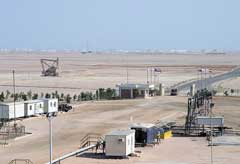Under the program on working with LUKOIL?s stockholders and investors, a group of representatives from investor companies, business analysts and business media journalists have visited Egypt, where LUKOIL Overseas is implementing several upstream projects.
Nearly fifty people took part in the three-day visit, including representatives from such major Russian and foreign investment and consulting firms and banks as J.P. Morgan, Brunswick UBS, Claridien Bank, Raiffeisenbank Austria, UFG, PFC Energy, Prince Street Capital, CEBR, Platt?s, Aton Capital, Lehman Brothers, PioGlobal, Renaissance-Capital, Metropol, Zenit bank, FinAm, Bank of Moscow, Troika-Dialog and others.
Guests met with Egyptian oil minister Sameh Fahmi and the heads of the national petroleum company EGPS, South Valley (GANOPE) and Tharwa oil companies, as well as the EGAS gas company and Egyptian Petrochemicals Holding. In addition, LUKOIL Overseas president Andrey Kuzyaev told the investors, business analytics and journalists about LUKOIL?s current and future project implementation efforts in North Africa and the Middle East. The guests were then given a tour of the WEEM deposit that is in the vicinity of the town of Hurgada and the Gulf of Suez in the Red Sea, where the LUKOIL Overseas offshore contact areas are situated.
The concession agreement on the West Esch El Mallaha (WEEM) block was drawn up in 1993, with a commercial strike being announced in January 1998. LUKOIL Overseas holds a 50% stake in the concession. Oil production totaled 535,000 tonnes of oil in 2003 vis-à-vis 363,800 tonnes in 2002 and 72,700 tonnes in 2001. The project has been generating a profit since May 2002, with the operating profit exceeding $30 million in 2003.
Construction of a pipeline towards the shore-based terminal is being completed. Next year, an oil treatment plant is slated for construction and extra drilling is planned. LUKOIL?s chunk of the recoverable reserves at the block is estimated at 14 million barrels of oil.
Furthermore, LUKOIL teamed up with ENI Agip and set up the LUKAgip joint venture that has been running the Meleiha project in Egypt, with 2003 oil output being around 660,000 tonnes. Over the past five years, the project has been generating income, with annual operating costs dropping. LUKOIL?s share in the project is 12%.
In July 2003, the Egyptian Oil Ministry and LUKOIL signed concession agreements on exploration and development of the Northeast Gheisum and West Gheisum blocks situated in the Gulf of Suez not far from Egypt?s coast. Total resources of the two blocks are estimated at 423.8 millions barrels of oil equivalent at the most. Within the blocks, seven prospective oil and gas bearing structures were discovered. The blocks? total area is about 176 sq.km.
The prospecting program is designed to last four years and provides for a 3D seismic survey to be conducted and eight exploratory wells to be drilled. The initial minimum exploration investment program is planned at about $27.8 million. The total sum of the investment is in the neighbourhood of 230 million.
The 3D offshore seismic survey kicked off at the West Gheisum block in February this year. The contractor is the well-known Western Geco company affiliated with the Schlumberger Group ? a world-leading technical service provider. The contractor was selected in a tender held by LUKOL Overseas late last year, and work will continue until late April. The total area to be covered by the seismic survey is 105 sq.km.
At the same time, reinterpretation of previous data is being conducted at the Northeast Gheisum block. If exploration proves successful, oil production could start in 2007.
Work at the Northeast Gheisum and West Gheisum blocks will allow for combining the infrastructure of the blocks and those of the WEEM oilfield group, thus producing synergy.
|
Angehängte Grafik:
title.jpg
